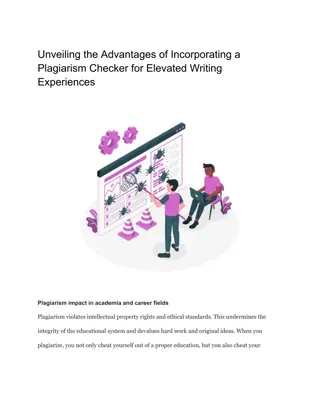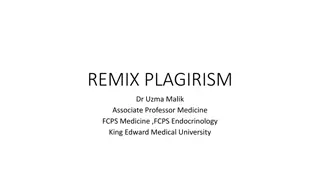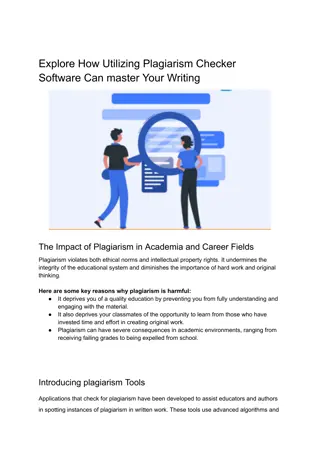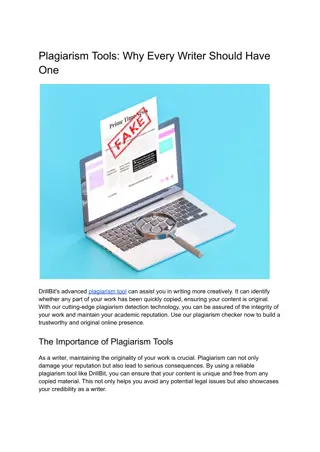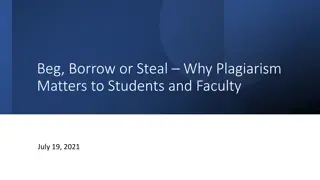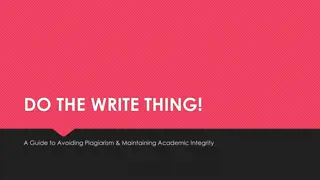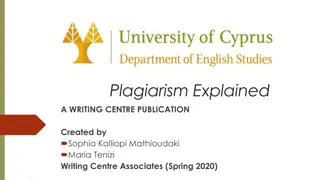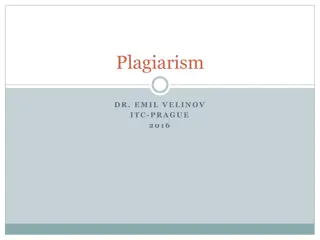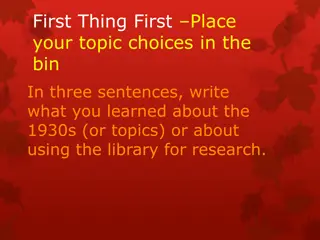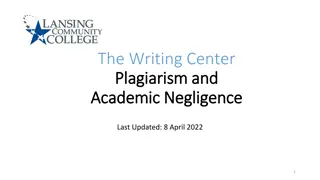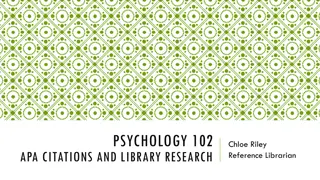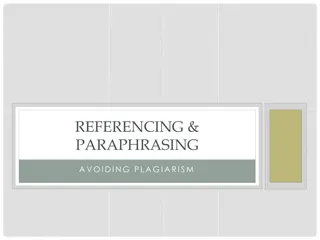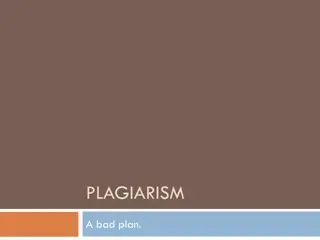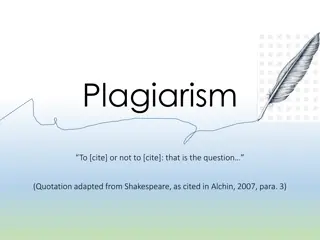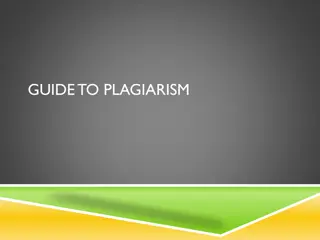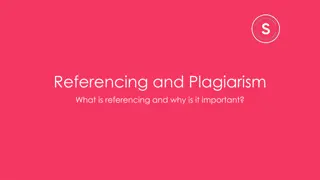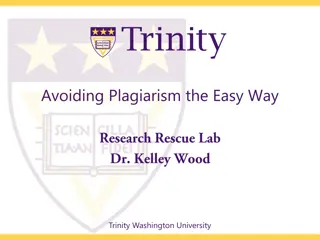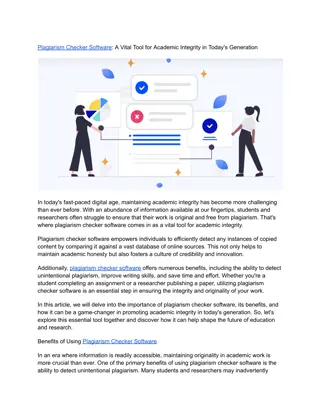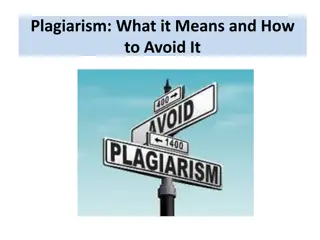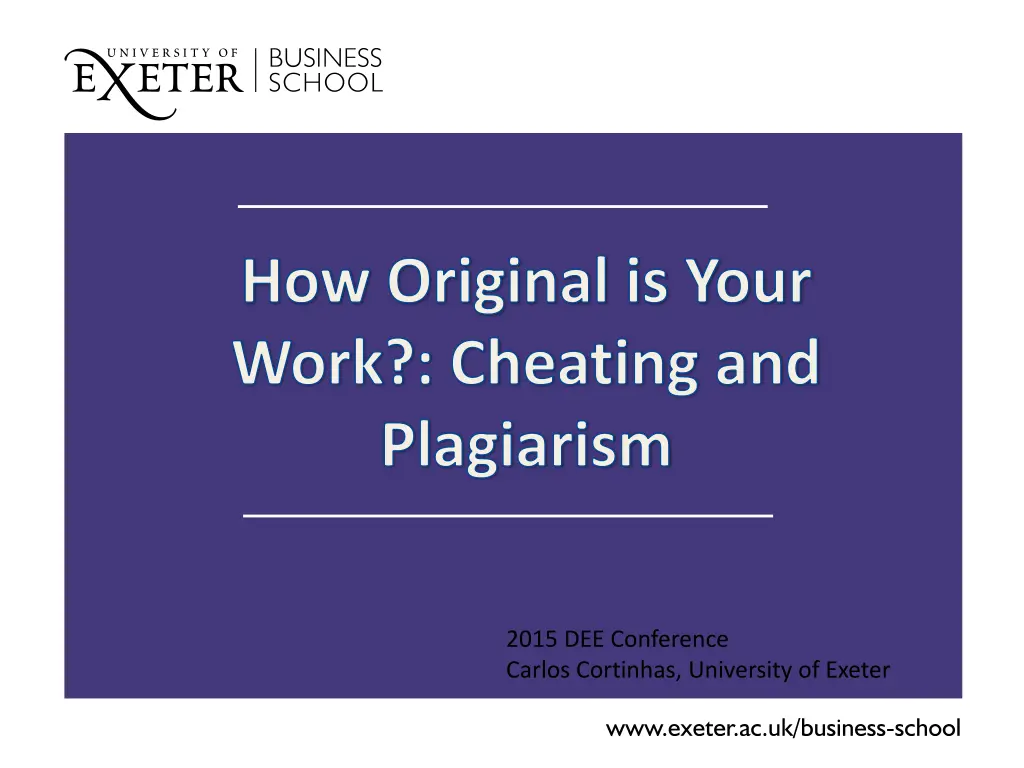
Challenges in Detecting Plagiarism: Insights & Solutions
Explore the complexities surrounding plagiarism detection in academic settings, including defining plagiarism, dealing with large class sizes, international student understanding, and the impact of new technologies. Discover the role of Turnitin as a powerful tool for detecting plagiarism and collusion, its advantages in checking submissions against vast databases, and potential issues such as time consumption and student manipulation.
Download Presentation

Please find below an Image/Link to download the presentation.
The content on the website is provided AS IS for your information and personal use only. It may not be sold, licensed, or shared on other websites without obtaining consent from the author. If you encounter any issues during the download, it is possible that the publisher has removed the file from their server.
You are allowed to download the files provided on this website for personal or commercial use, subject to the condition that they are used lawfully. All files are the property of their respective owners.
The content on the website is provided AS IS for your information and personal use only. It may not be sold, licensed, or shared on other websites without obtaining consent from the author.
E N D
Presentation Transcript
How Original is Your Work?: Cheating and Plagiarism 2015 DEE Conference Carlos Cortinhas, University of Exeter
Plan Challenges Detecting Plagiarism Avoiding Plagiarism
Challenges Plagiarism can be difficult to define (when does sloppy referencing become serious plagiarism ?) Most Economics Departments have very large class sizes which makes knowing each student s work difficult Diverse student body which often does not understand what plagiarism is (especially true for some International students) Self-plagiarism = Plagiarism? If so, what proportion is acceptable? New technologies can make plagiarism easier to do and harder to detect (e.g. http://www.oxbridgeessays.com/prices )
Detecting Plagiarism: Turnitin There are a number of software solutions to help detect plagiarism but the most commonly used by far is TURNITIN Turnitin is a Web-based management of assignments and feedback with simultaneous check for Plagiarism and Collusion (also includes Grademark and PeerMark).
Turnitin Main advantages: It is a powerful tool to check for plagiarism/collusion Turnitin compares each assignment with its database of +45 billion web pages, 337+ million student papers and 130+ million articles from academic books and publications An Originality Report can be generated for each piece of work submitted It can be a powerful tool to teach students about plagiarism as well as to safeguard academic integrity It can allow students to check for collusion and plagiarism in their work, and to correct bad practices before final submission of work. It is integrated into the Virtual Learning Environment.
Turnitin Main problems: Turnitin does not compare the paper with older works, available only on paper It can be very time consuming to determine whether plagiarism/collusion took place High similarity scores do not immediately imply plagiarism which makes the task of detecting plagiarism difficult There is no magic cut-off point that defines plagiarism despite several universities having these in place (e.g. plagiarism = 50% similarity index) The software can be manipulated by students if they can see their reports and resubmit their work
Turnitin: setting an assignment Because the software is integrated in the VLE s, setting assignments is very straight forward.
Turnitin: Advanced Options There are three options for Report Generation Speed : Generate reports immediately (resubmissions are not allowed) Generate reports immediately (resubmissions are allowed until due date) Generate reports on due date (resubmissions are allowed until due date)
Avoiding Plagiarism: Some ideas The best and most successful way to avoid plagiarism is to design assignments in ways that plagiarism is discouraged: Avoid general questions whenever possible, individualize questions (e.g. each student/group is asked to use data from different countries, maths problems use randomly generated data, etc.) taylor assignments to the content that was taught/discussed in the classroom or to specific events that occurred recently One version might be to require the inclusion of specific texts or sources
Avoiding Plagiarism (II) Create several stages that require contact with the academic in a sequential, incremental manner: E.g. students might be asked to submit a 2 page proposal by week 2, literature review by week 6, oral presentation by week 8, etc When feasible, require students to meet face-to-face at specific times to discuss progress in the assignment An alternative for large classes might be to create a peer review exercise where students give feedback on each other s work in relation to pre-determined marking criteria Additional advantage of making students understand what they will be assessed on and make students answer specific questions
Avoiding Plagiarism (III) An alternative for regular one-to-one meetings when large classes exist might be to create a peer review exercises where students give feedback on each other s work in relation to pre- determined marking criteria Peer review feedback (and the student s response to it) if included in the assignment will make cheating much harder Additional advantage of making students understand what they will be assessed on and make students answer specific questions
Avoiding Plagiarism (IV) Coach students about the research process Discussing the process in class and providing good and bad examples of paraphrasing, citations, footnotes, etc will help students understand (i) how difficult and time consuming the process of writing can be (ii) acknowledging sources does not reduce the value of one s work
Avoiding Plagiarism (V) Consider non-traditional formats where appropriate Instead of essays you might ask for a report, executive summary or policy brief, etc These formats encourage students to interpret their research into their own words Less likely to find these types of formats online

